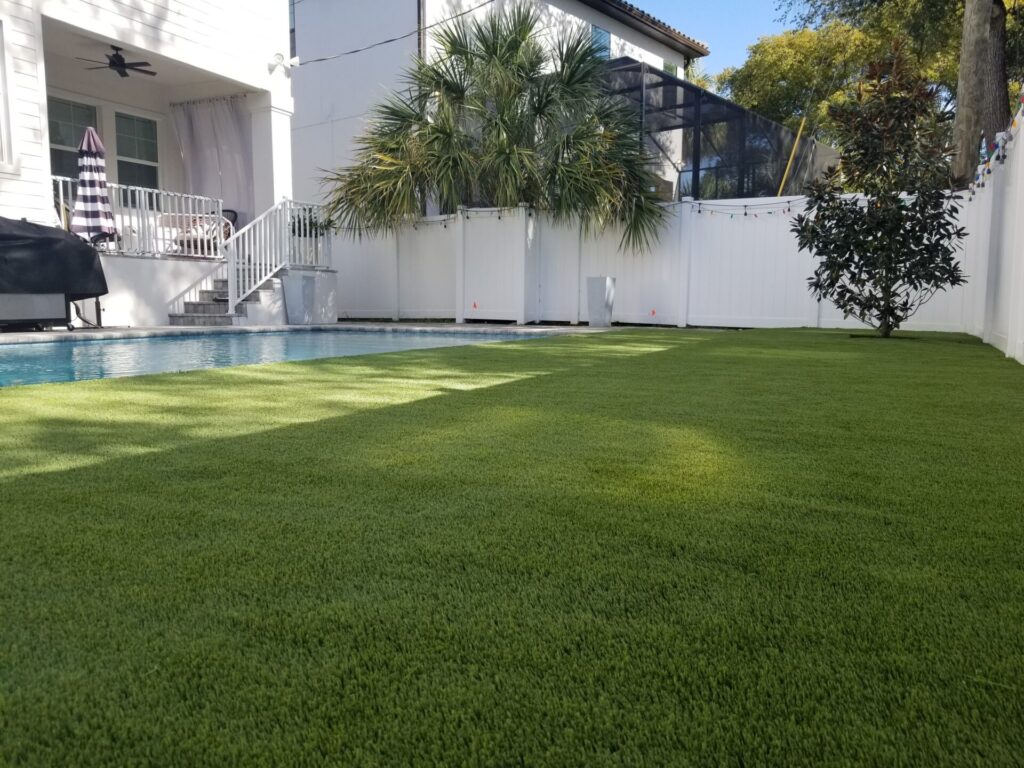Why You Should Consider Artificial Grass for Your Pool Deck
If you’re looking to enhance the area around your swimming pool, artificial grass might be the perfect solution. Not only does it offer aesthetic appeal, but it also provides a range of practical benefits that can transform your pool deck into a stylish and functional space. Here’s why you should consider artificial grass for your pool deck.
1. Enhanced Safety
Safety is a top priority around any pool, and artificial grass contributes to a safer environment. Unlike traditional decking materials that can become slippery when wet, synthetic turf offers a slip-resistant surface that reduces the risk of accidents. Its cushioned texture also helps prevent injuries from slips and falls, making it an ideal choice for families with children and pets.
2. Cooler Underfoot
Traditional pool deck materials like concrete or pavers can get extremely hot under the sun, making it uncomfortable to walk on. Artificial grass, on the other hand, stays cooler underfoot, providing a more pleasant and comfortable surface around your pool. This can enhance the overall enjoyment of your pool area, especially during hot summer days.
3. Low Maintenance
Maintaining a pool deck can be time-consuming, but artificial grass simplifies the process. Unlike natural grass, synthetic turf requires no mowing, watering, or fertilizing. It’s also resistant to weeds and pests, which means less hassle for you. With minimal upkeep, you can spend more time enjoying your pool rather than working on maintenance.
4. Superior Drainage
Artificial grass is designed with advanced drainage systems that efficiently manage water flow. This is particularly beneficial around pools, where water splashes and spills are common. The turf’s drainage capabilities ensure that water quickly and effectively drains away, reducing the likelihood of puddles and keeping your pool deck clean and dry.
5. Aesthetic Appeal
Astroturf provides a lush, green look that enhances the visual appeal of your pool deck. It creates a beautiful contrast with the blue of the pool and the surrounding landscape, adding a touch of elegance to your outdoor space. With a variety of styles and colors available, you can choose a synthetic grass that perfectly complements your pool area’s design.
6. Durability and Longevity
Artificial grass is built to withstand heavy foot traffic and harsh weather conditions, making it a durable choice for pool decks. It maintains its appearance and functionality over time, even with constant use. This longevity means you’ll enjoy a pristine and attractive pool area for years to come, without the need for frequent replacements.
7. Eco-Friendly Choice
Synthetic turf is an environmentally friendly option, especially in terms of water conservation. By choosing artificial grass, you eliminate the need for regular watering, which helps conserve water and reduce your environmental footprint. It also eliminates the use of chemicals and fertilizers, contributing to a healthier environment.
Conclusion
Artificial grass offers a range of benefits that make it an excellent choice for enhancing your pool deck. From improved safety and comfort to low maintenance and aesthetic appeal, synthetic turf can transform your pool area into a stylish and functional space. By investing in artificial grass, you can create a beautiful, durable, and eco-friendly outdoor area that will enhance your enjoyment of your pool for years to come.
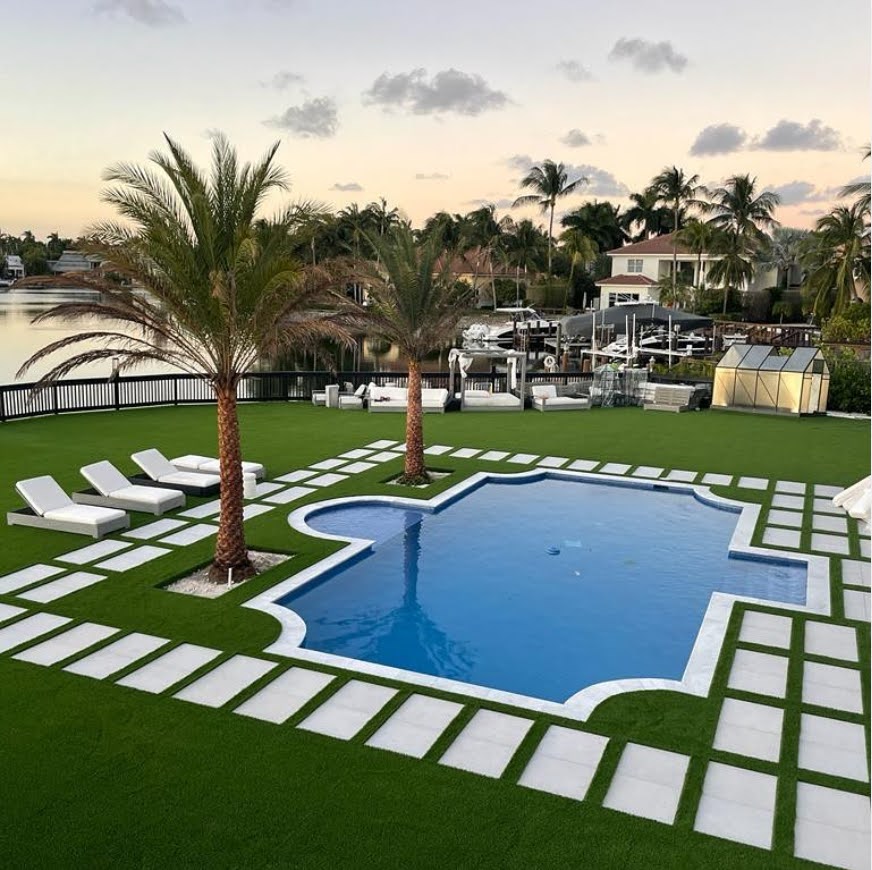
Paver Installation for Your Home – What You Should Know
When it comes to transforming your home’s outdoor spaces, paver installation is a top choice for homeowners seeking durability, beauty, and functionality. Pavers are versatile and can be used for driveways, patios, walkways, and pool decks, providing both aesthetic and practical benefits. If you’re considering paver installation for your home, here’s everything you should know before you get started.
1. Choosing the Right Type of Paver
Pavers come in a variety of materials, each with its unique properties and aesthetic appeal. Some of the most popular types of pavers include:
- Concrete Pavers: These are affordable, durable, and available in a wide range of colors and shapes. They offer versatility in design and are often used for modern, clean-lined projects.
- Brick Pavers: Classic and timeless, brick pavers offer a warm, traditional look. They are durable and easy to maintain, making them ideal for driveways and walkways.
- Natural Stone Pavers: Known for their natural beauty and elegance, stone pavers like flagstone, travertine, or granite can elevate the look of any outdoor space. While more expensive, their durability and unique appearance make them a great investment.
- Permeable Pavers: These eco-friendly pavers allow water to pass through, helping with drainage and reducing runoff. They’re perfect for areas prone to heavy rainfall or if you’re looking to reduce your environmental impact.
The type of paver you choose will depend on your design goals, budget, and the specific needs of your outdoor space.
2. The Importance of a Solid Base
A proper paver installation begins with a well-prepared base. The success and longevity of your paver project depend on the foundation. This involves excavating the area, compacting the soil, and laying a base material like gravel or crushed stone to ensure proper drainage and support.
Without a solid base, pavers can shift, sink, or crack over time, leading to uneven surfaces or water pooling. A professional installer will ensure that the base is adequately prepared to handle both the weight of the pavers and any vehicles or foot traffic that the area will see.
3. Design Flexibility
One of the biggest advantages of pavers is the endless design possibilities they offer. Whether you’re creating a simple patio or a more intricate driveway, pavers allow for a variety of patterns and layouts, including:
- Herringbone Pattern: This zig-zag design is one of the most popular, offering strength and a visually appealing look.
- Basketweave Pattern: This creates a classic, woven appearance using two pavers laid horizontally and two vertically.
- Running Bond: This simple, linear pattern is great for walkways and driveways, creating a streamlined look.
You can also mix and match paver colors and textures to create borders, accents, or unique focal points in your outdoor space. The versatility of pavers makes them ideal for creating customized looks that reflect your personal style.
4. Maintenance and Longevity
One of the key reasons homeowners choose pavers is their low maintenance. However, while they’re durable, there are a few steps you can take to keep your pavers looking their best for years to come:
- Regular Cleaning: Sweep your pavers regularly to prevent dirt and debris buildup. You can also use a garden hose or pressure washer for a deeper clean.
- Weed Prevention: Weeds can sometimes grow between paver joints, but applying polymeric sand during installation can help prevent this. It hardens when wet and locks the pavers, reducing weed growth.
- Sealants: Consider sealing your pavers every few years to protect them from stains, weather damage, and fading. This is especially important if your pavers are exposed to heavy traffic or direct sunlight.
By maintaining your pavers, you’ll ensure they retain their color, integrity, and beauty over time, making them a cost-effective, long-lasting solution for outdoor areas.
5. Weather and Drainage Considerations
Tampa’s frequent rain and occasional hurricanes can impact your outdoor space. The good news is that pavers, when installed correctly, offer excellent drainage solutions. The joints between pavers allow water to flow naturally into the ground, reducing the risk of standing water and flooding.
If you live in an area prone to heavy rain, you might also consider permeable pavers. These are designed specifically to allow water to seep through, helping to manage runoff and prevent erosion. Proper drainage planning is key to ensuring that your paver installation lasts and performs well over time.
6. Cost and Value
The cost of a paver installation project can vary depending on factors like the size of the area, the type of pavers used, and the complexity of the design. While pavers may have a higher upfront cost than materials like poured concrete, they offer long-term value in terms of durability and aesthetic appeal.
Paver installations can also increase your home’s property value. A well-designed driveway, patio, or walkway adds curb appeal and creates functional outdoor living spaces, making your home more attractive to potential buyers if you ever decide to sell.
7. Professional Installation vs. DIY
While it’s tempting to consider a DIY paver installation to save money, this type of project requires skill, precision, and proper tools. Incorrect installation can lead to drainage issues, shifting pavers, and uneven surfaces, which can end up costing more to fix in the long run.
Hiring a professional ensures that your paver project is installed correctly from the start. Professionals will handle everything from excavation and base preparation to laying the pavers and securing the edges. The investment in a professional installer guarantees that your pavers will be durable, properly aligned, and aesthetically pleasing.
Conclusion
Paver installation is an excellent way to enhance the look, function, and value of your home’s outdoor areas. With their durability, design flexibility, and low maintenance, pavers offer a long-lasting solution that can transform your driveway, patio, or walkway into a beautiful and functional space. By choosing the right type of paver, ensuring proper installation, and maintaining your investment, you can enjoy the benefits of pavers for many years to come.
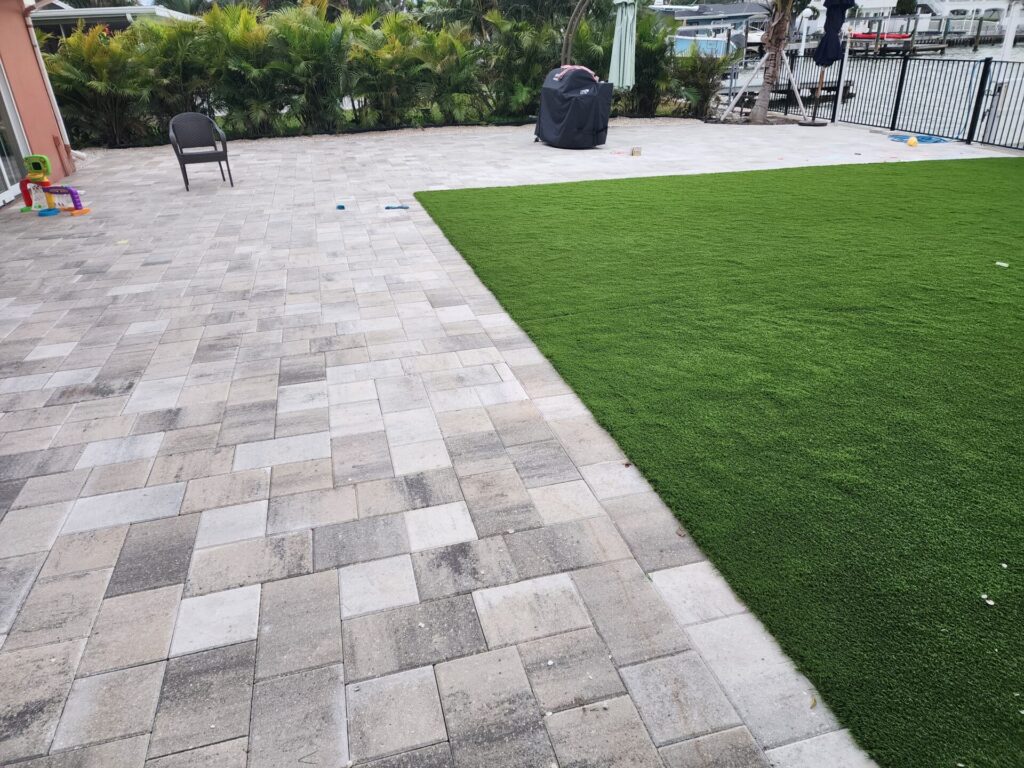
You Should Consider Paver Installation with Artificial Grass
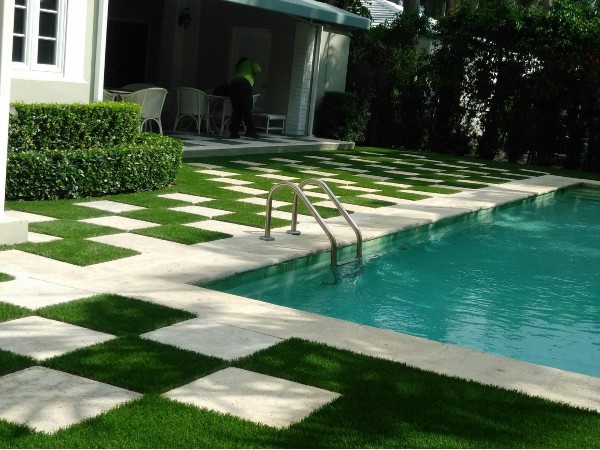
What to Know Before Installing Synthetic Turf
1. Initial Cost
While synthetic turf installation offers long-term savings due to reduced maintenance, the initial installation cost is higher than planting natural grass. The price of synthetic turf installation depends on factors such as the size of the area, the type of turf you choose, and any additional features like underlayment or edging. However, when you factor in the long-term savings on water, lawn care, and equipment, the investment often pays off over time.
2. Choose the Right Turf for Your Needs
Not all synthetic turf is created equal, so it’s important to choose the right type for your yard’s specific needs. Consider factors such as the amount of foot traffic the area will receive, whether pets will be using the space, and the look and feel you want to achieve. There are options with different pile heights, blade textures, and colors to suit everything from residential lawns to playgrounds or sports fields.
3. Professional Installation is Key
To ensure your synthetic turf performs well and lasts for years, professional turf installation is essential. Installing artificial grass requires proper preparation of the ground, including leveling, adding a base layer, and ensuring good drainage. A professional installer will also ensure the turf is securely anchored and seams are properly joined, providing a flawless finish that looks natural.
4. Regular Maintenance is Minimal but Necessary
While synthetic turf is low-maintenance, a small amount of upkeep is still required to keep it looking its best. This may include brushing the turf to keep the blades upright, removing debris such as leaves or twigs, and occasionally rinsing it to remove dirt or pet waste. These simple steps will help your turf maintain its appearance and functionality over time.
Conclusion
Artificial grass is a great option for homeowners looking to create a low-maintenance, durable, and beautiful yard. With benefits such as water conservation, pet-friendliness, and year-round aesthetic appeal, artificial grass is a smart investment for modern landscapes. By understanding the key aspects of installation and selecting the right type of turf for your needs, you can enjoy a pristine, hassle-free yard for years to come.
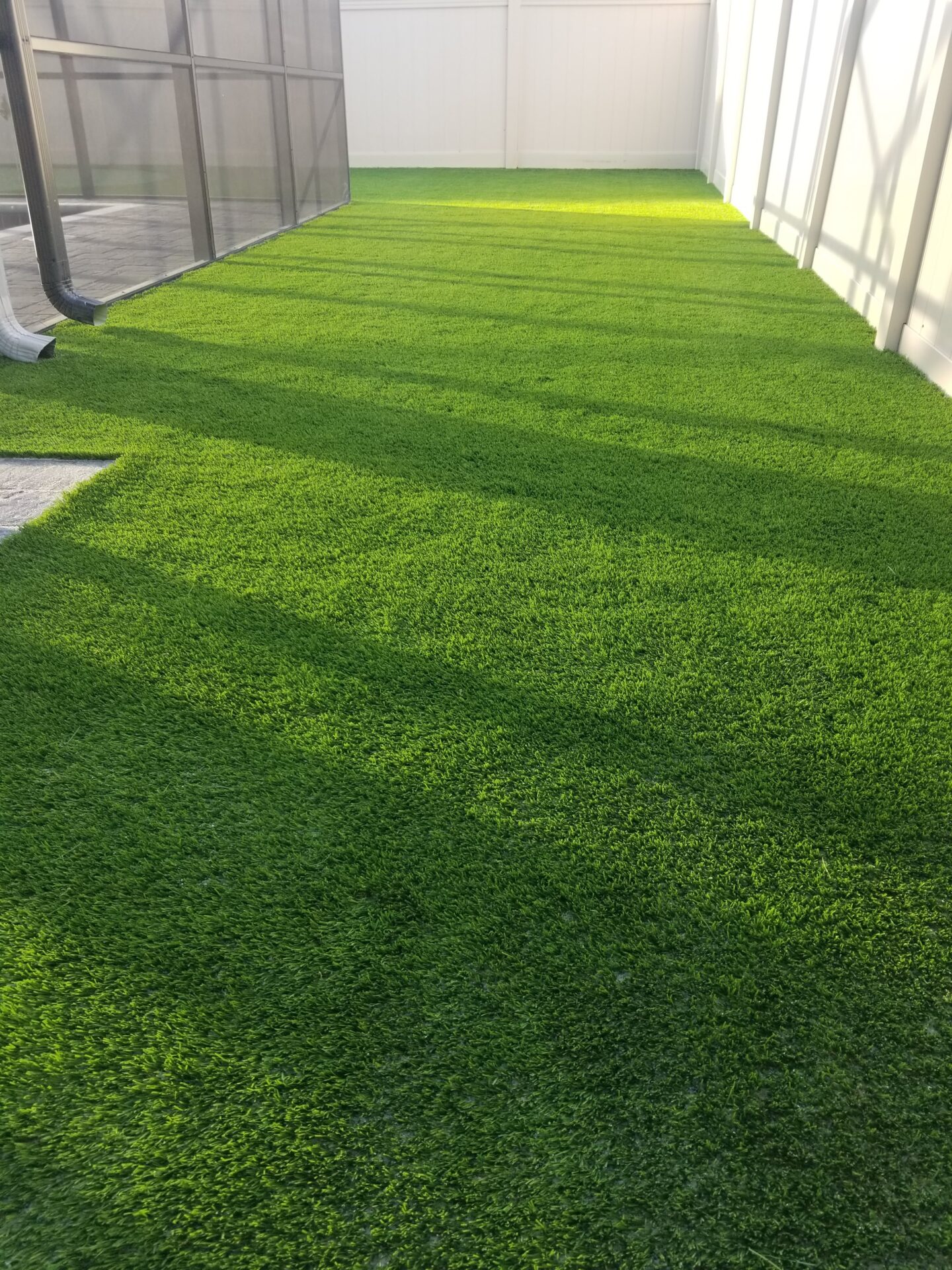
Synthetic Turf: Why It’s a Great Option for Your Yard
As homeowners continue to explore alternatives to traditional lawns, synthetic turf has emerged as a leading choice for those looking to create beautiful, low-maintenance outdoor spaces. If you’re considering making the switch to artificial grass, it’s important to understand the benefits it offers, as well as what you need to know before installation. Here’s a comprehensive guide on why synthetic turf could be the perfect option for your yard.
1. Minimal Maintenance
One of the standout benefits of synthetic turf is the minimal upkeep it requires. Unlike natural grass, which needs regular mowing, watering, fertilizing, and weeding, synthetic turf remains lush and green year-round with little effort. No more spending weekends tending to your lawn—synthetic turf frees up your time, allowing you to enjoy your yard instead of maintaining it.
2. Water Conservation
In regions where water conservation is essential, synthetic turf is an eco-friendly solution. Traditional lawns need a significant amount of water, especially in dry climates, to stay healthy and green. Synthetic turf, however, doesn’t require any watering, except for occasional rinsing to clean off dirt or pet waste. This not only helps conserve water but also lowers your utility bills, making synthetic grass both environmentally and financially smart.
3. Durable and Long-Lasting
Synthetic turf is designed to withstand heavy foot traffic, harsh weather, and wear and tear. Whether you have kids playing in the yard, pets running around, or you’re hosting outdoor events, synthetic turf is built to last. High-quality artificial grass can maintain its appearance and performance for 15 years or more, making it a long-term investment for your home.
4. Aesthetically Pleasing
Modern synthetic turf looks and feels like natural grass, offering an aesthetically pleasing alternative to traditional lawns. Available in a variety of colors, textures, and pile heights, artificial grass can mimic the appearance of real grass, ensuring your yard always looks pristine. You won’t have to worry about brown patches, weeds, or uneven growth—your synthetic turf will stay green and lush all year long.
5. Pet-Friendly and Easy to Clean
For pet owners, synthetic pet turf is a fantastic option. It’s durable enough to withstand your pets’ activity and easy to clean, as pet waste can be quickly removed and the area can be rinsed to keep it fresh. Many synthetic turf products are designed with antimicrobial properties to help reduce odors and bacteria, creating a cleaner environment for both pets and homeowners.
6. Safe and Non-Toxic
Synthetic turf eliminates the need for potentially harmful chemicals such as fertilizers, pesticides, and herbicides that are often used on natural grass. This makes it a safer option for children and pets who spend time playing outdoors. Additionally, synthetic turf is made from non-toxic materials, ensuring that your yard is a safe place for the whole family to enjoy.
7. Ideal for All Weather Conditions
One of the main challenges with natural grass is maintaining it in different weather conditions. Heavy rain can cause mud and puddles, while heat and drought can leave your lawn looking dry and brown. Synthetic turf, however, is designed to perform in all weather conditions. Its efficient drainage system prevents standing water, and it won’t fade or die in extreme temperatures, giving you a perfect-looking lawn year-round.
8. Versatility in Design
Artificial grass isn’t just for lawns—it’s highly versatile and can be used for various landscaping projects. From backyard putting greens and children’s play areas to rooftop gardens and poolside designs, artificial grass can be installed in areas where natural grass might not thrive. It can even be customized to fit unique shapes and layouts, making it a flexible solution for creative outdoor spaces.
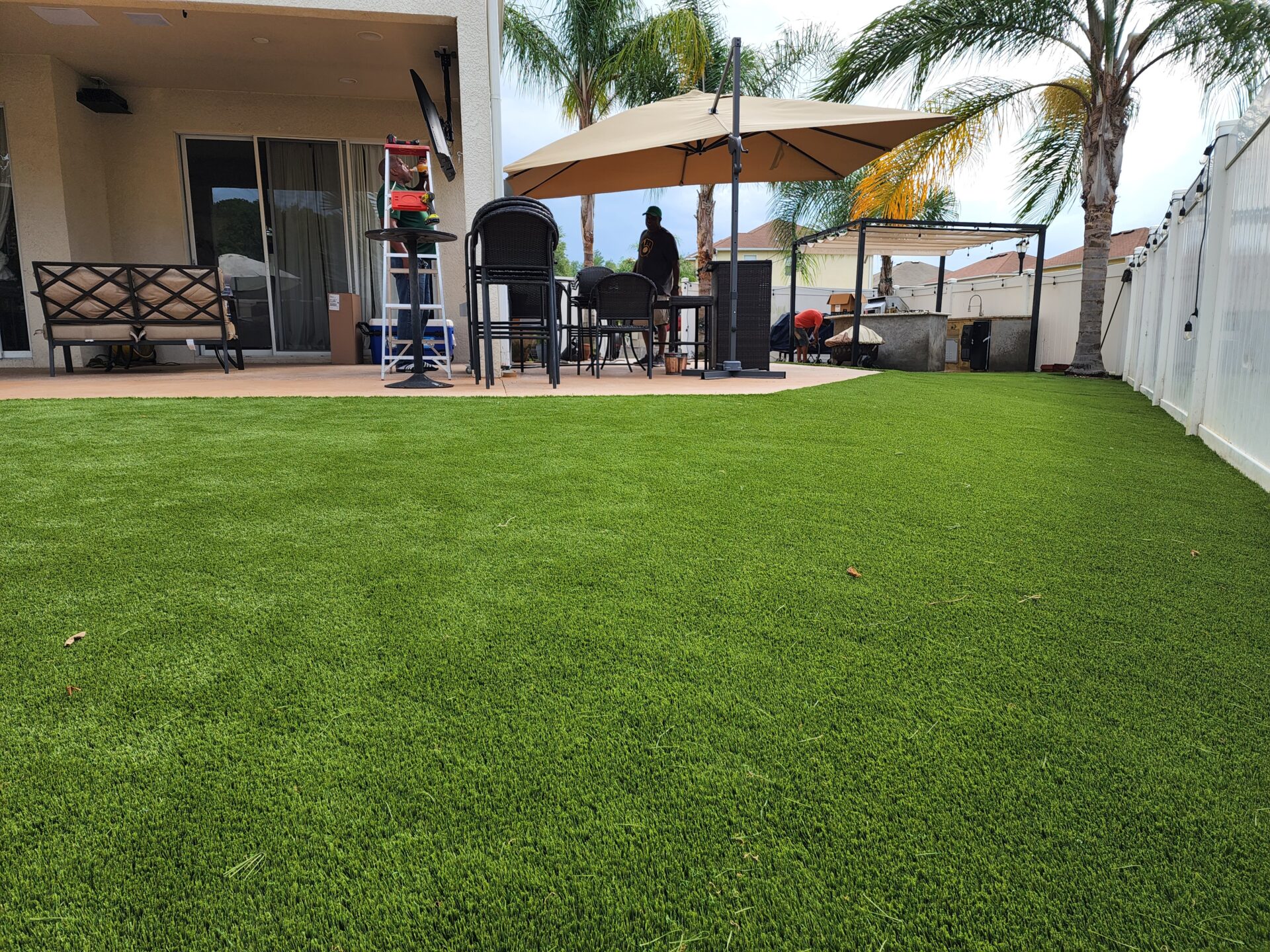
Things to Know When Looking at Synthetic Grass
While synthetic turf offers numerous benefits, such as low maintenance and water conservation, it’s important to consider potential hazards and challenges associated with its installation and use. Here are some of the key hazards to be aware of when opting for synthetic turf:
1. Heat Retention
Artificial turf can absorb and retain heat, especially in hot climates, making the surface uncomfortable to walk on barefoot or for pets. The high temperatures can also pose a risk of burns. Choosing turf with cooling technology or using shade structures can mitigate this issue.
2. Environmental Concerns
While artificial grass reduces water usage and eliminates the need for chemical fertilizers and pesticides, its production and disposal have environmental impacts. The manufacturing process can contribute to pollution, and disposing of old turf can be challenging due to its composition of non-biodegradable materials.
3. Drainage Issues
Proper installation is crucial for effective drainage. Poorly installed synthetic turf can lead to water pooling on the surface or inadequate drainage, which can cause mold, mildew, and odors. Ensuring that the turf is installed with a proper drainage system is essential.
4. Injury Risks
Although synthetic turf provides a consistent playing surface, it may not offer the same level of cushioning as natural grass. This can increase the risk of injuries, particularly in high-impact sports. Choosing a turf system with adequate padding and infill can help reduce this risk.
5. Toxic Runoff and Materials
Some synthetic turf products may contain potentially harmful chemicals, such as heavy metals and volatile organic compounds (VOCs), which can leach into the environment. Opting for high-quality, eco-friendly turf products can help minimize this risk.
6. Static Electricity
Synthetic turf can generate static electricity, particularly in dry conditions. This can be an annoyance for people and pets and might also pose a risk to electronic devices. Using anti-static infill or treatments can help reduce static build-up.
7. Cost of Installation and Replacement
While synthetic turf can save money on maintenance over time, the initial installation cost can be high. Additionally, synthetic turf has a finite lifespan (typically 10-15 years) and will need to be replaced eventually, which can be a significant expense.
8. Loss of Natural Benefits
Natural grass offers several environmental benefits, including carbon dioxide absorption, natural cooling, and habitat for insects and small animals. Replacing grass with synthetic turf can lead to a loss of these benefits, potentially impacting local ecosystems.
9. Potential for Algae and Mold Growth
If synthetic turf does not dry properly or is installed in a damp area, there is a risk of algae and mold growth. This can lead to unpleasant odors and slippery surfaces. Proper installation and regular maintenance can help prevent these issues.
By being aware of these potential hazards, you can take the necessary steps to mitigate risks and make an informed decision about installing synthetic turf.
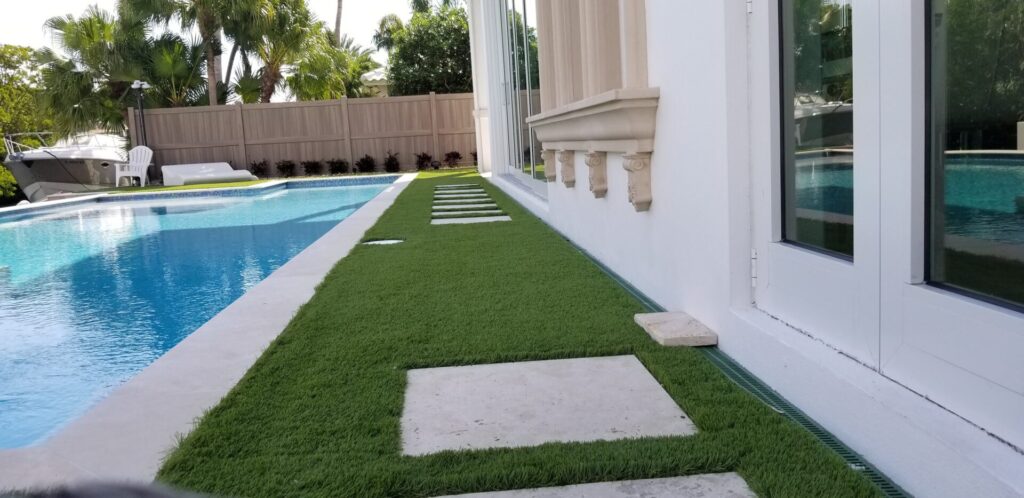
How to Keep Your Artificial Turf Looking Like New
Maintaining the fresh, vibrant appearance of your artificial turf is simpler than you might think. With the right approach and a few regular tasks, you can keep your synthetic lawn looking pristine for years to come. Here’s a guide to help you ensure your artificial turf stays as good as new.
1. Regular Cleaning
Regular cleaning is essential to maintain the appearance and hygiene of your artificial turf. Remove leaves, twigs, and other debris using a leaf blower, rake, or broom. This prevents the accumulation of organic matter, which can encourage mold and mildew growth. For pet owners, promptly removing solid waste and rinsing the area with water can prevent unpleasant odors and keep the turf looking its best.
2. Brush the Turf
High-traffic areas of your turf may flatten over time. To counter this, brush the turf regularly with a stiff-bristled broom or a specialized turf brush. This helps keep the grass blades upright and restores the turf’s lush, natural appearance. The frequency of brushing depends on the level of use; generally, brushing once a month is sufficient for most residential lawns.
3. Prevent and Control Weeds and Moss
Weeds can occasionally grow along the edges of synthetic turf or within the infill. Applying a non-toxic weed killer or manually removing weeds as they appear helps keep your lawn weed-free. In damp and shaded areas, moss and algae can develop. Prevent this by ensuring proper drainage and applying moss or algaecide as needed.
4. Maintain Infill Levels
The infill in your artificial turf helps maintain its cushioning and drainage capabilities. Over time, the infill can become compacted or uneven. Check and replenish the infill regularly to ensure your turf retains its soft, springy feel. Consult with your installer about the best type of infill for your specific needs, as different materials (such as sand or rubber) may have varying maintenance requirements.
5. Seasonal Care
Artificial turf can be affected by extreme weather conditions. In hot climates, the surface can become very warm; rinsing it with water during the hottest parts of the day can help cool it down. In colder climates, remove snow with a plastic shovel to avoid damaging the fibers. Avoid using metal tools or salt on your turf.
6. Address Minor Repairs Promptly
Minor damages, such as tears or loose seams, should be addressed quickly to prevent them from becoming bigger issues. Small repairs can often be done by the homeowner or a professional turf installer. Regularly inspecting your turf for signs of wear and damage can help catch problems early.
7. Professional Maintenance
Occasionally, professional maintenance can give your artificial turf a more thorough cleaning and grooming. Professionals can use specialized equipment to deep clean the turf, rejuvenate the infill, and ensure that your lawn remains in top condition.
By following these maintenance tips, you can keep your astroturf looking like new. A well-maintained synthetic lawn provides a beautiful, functional outdoor space with minimal effort, allowing you to enjoy a lush, green landscape year-round.
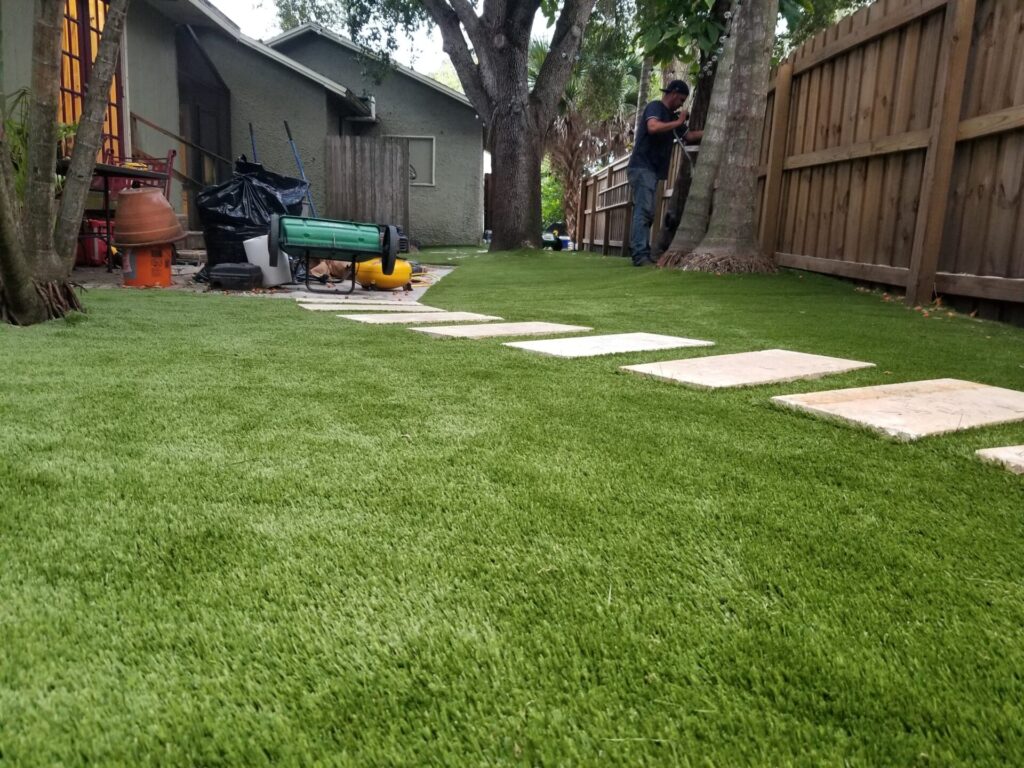
What to Look for in a Synthetic Grass Installation
Synthetic turf has become famous for homeowners and businesses due to its low maintenance, aesthetic appeal, and durability. However, choosing the right company to install synthetic grass is crucial to ensure you maximize your investment. Here are vital factors to consider when selecting an artificial grass installation company:
1. Experience and Expertise
- Years in Business: Look for companies with several years of experience in the industry. Longevity often indicates reliability and a proven track record.
- Specialization: Ensure the company specializes in synthetic grass installation. Companies that handle various types of landscaping may not have the specific skills and knowledge required for high-quality synthetic grass installation.
2. Quality of Materials
- Grass Quality: Ask about the types of artificial grass they offer. High-quality synthetic grass should be UV-resistant, durable, and look natural.
- Infill Options: The type of infill used can affect the grass’s performance and feel. Common infill materials include sand, rubber, and organic infill. Understand the pros and cons of each.
3. Installation Process
- Site Preparation: Proper site preparation is crucial for a successful installation. The company should remove existing vegetation, level the ground, and ensure proper drainage.
- Installation Techniques: Inquire about their installation techniques. Proper seam joining, secure anchoring, and edge finishing are important for durability and appearance.
4. Portfolio and References
- Previous Work: Review their portfolio to see past projects. This can give you an idea of their workmanship and the types of projects they handle.
- References and Reviews: Ask for references and check online reviews. Speaking with past clients can provide insight into the company’s reliability, professionalism, and quality of work.
5. Cost and Value
- Detailed Estimates: Obtain detailed estimates from multiple companies. The estimate should include all costs, such as materials, labor, site preparation, and any additional services.
- Value for Money: Don’t automatically go for the cheapest option. Consider the quality of materials and workmanship. Investing in a higher quality installation can save money in the long run by reducing maintenance and replacement costs.
6. Warranty and Aftercare
- Warranty: A good company should offer a warranty on both the materials and the installation. Understand the terms and conditions of the warranty.
- Maintenance Services: Some companies offer ongoing maintenance services. Regular maintenance can extend the life of your synthetic grass and keep it looking its best.
7. Certifications and Insurance
- Certifications: Check if the company has relevant certifications from industry organizations. This can be an indicator of their commitment to quality and professionalism.
- Insurance: Ensure the company is fully insured. This protects you from liability in case of accidents or damage during the installation process.
8. Customer Service
- Communication: Evaluate their communication and responsiveness. A company that is easy to communicate with and responsive to your questions and concerns is more likely to provide a positive experience.
- Customization: Look for a company willing to work with you to customize the installation to your specific needs and preferences.
Conclusion
Choosing the right synthetic grass installation company is crucial in ensuring a successful and long-lasting installation. By considering factors such as experience, material quality, installation process, portfolio, cost, warranty, certifications, and customer service, you can make an informed decision and enjoy the benefits of a beautiful and low-maintenance synthetic lawn for years to come.

Things You May Not Know About Artificial Grass
Since its introduction, artificial grass has evolved into a versatile and sustainable alternative to natural lawns. Whether you’re considering installing artificial grass or simply curious about its benefits and features, here are some surprising things you may not know about this innovative product.
1. Environmental Benefits
Artificial grass is often seen as a more environmentally friendly option compared to natural grass. Here’s why:
- Water Conservation: Artificial grass requires no watering, which can significantly reduce water usage, especially in arid regions.
- No Pesticides or Fertilizers: Unlike natural grass, artificial turf doesn’t need chemical treatments to stay green and lush, reducing the environmental impact.
- Recyclable Materials: Many modern artificial grass products are made from recyclable materials, contributing to a more sustainable lifecycle.
2. Low Maintenance
One of the biggest advantages of artificial grass is its low maintenance requirements. Say goodbye to mowing, watering, and fertilizing. Occasional brushing and rinsing are usually enough to keep the turf looking great.
3. Durability
Artificial grass is incredibly durable and can withstand heavy foot traffic, making it ideal for high-use areas such as sports fields, playgrounds, and residential lawns. High-quality artificial grass can last up to 15 years or more with proper care.
4. Year-Round Greenery
Unlike natural grass, which can brown and wither during extreme weather conditions, artificial grass stays green and vibrant all year round. This makes it a perfect solution for maintaining a beautiful lawn in both hot summers and cold winters.
5. Versatility
Artificial grass isn’t just for lawns. It’s used in a variety of applications, including:
- Sports Fields: Many professional sports fields use artificial turf for its durability and consistent playing surface.
- Playgrounds: Soft and safe, artificial grass is a popular choice for playground surfaces.
- Balconies and Rooftops: Urban dwellers use artificial grass to create green spaces in apartments and condos.
- Pet Areas: Artificial grass is pet-friendly, providing a clean and comfortable area for pets to play.
6. Cost-Effectiveness
While the initial cost of installing artificial grass can be higher than natural grass, the long-term savings on water, maintenance, and lawn care products make it a cost-effective option over time.
7. Improved Technology
Advancements in technology have significantly improved the look and feel of artificial grass. Today’s products closely mimic the appearance and texture of natural grass, complete with variations in color and blade shape for a more realistic look.
8. Safety Features
Artificial grass is designed with safety in mind. Many products include features like non-toxic materials, anti-microbial properties to reduce bacteria buildup, and shock-absorbing layers to minimize injuries from falls.
9. Allergen-Free
For those with allergies, artificial grass is a great alternative to natural lawns, which can harbor pollen and other allergens. An artificial lawn can help reduce allergy symptoms and create a more comfortable outdoor environment.
10. DIY Friendly
Installing synthetic turf can be a DIY project for those with basic landscaping skills. Many companies provide detailed installation guides and support to help homeowners achieve professional results.
Conclusion
Artificial grass offers a range of benefits that extend beyond just having a green lawn. Its environmental advantages, low maintenance, durability, and versatility make it an excellent choice for various applications. As technology advances, artificial grass will likely become an even more popular and sustainable alternative to natural grass. Artificial grass provides a practical and attractive solution whether you’re looking to save water, reduce maintenance, or create a safe play area.
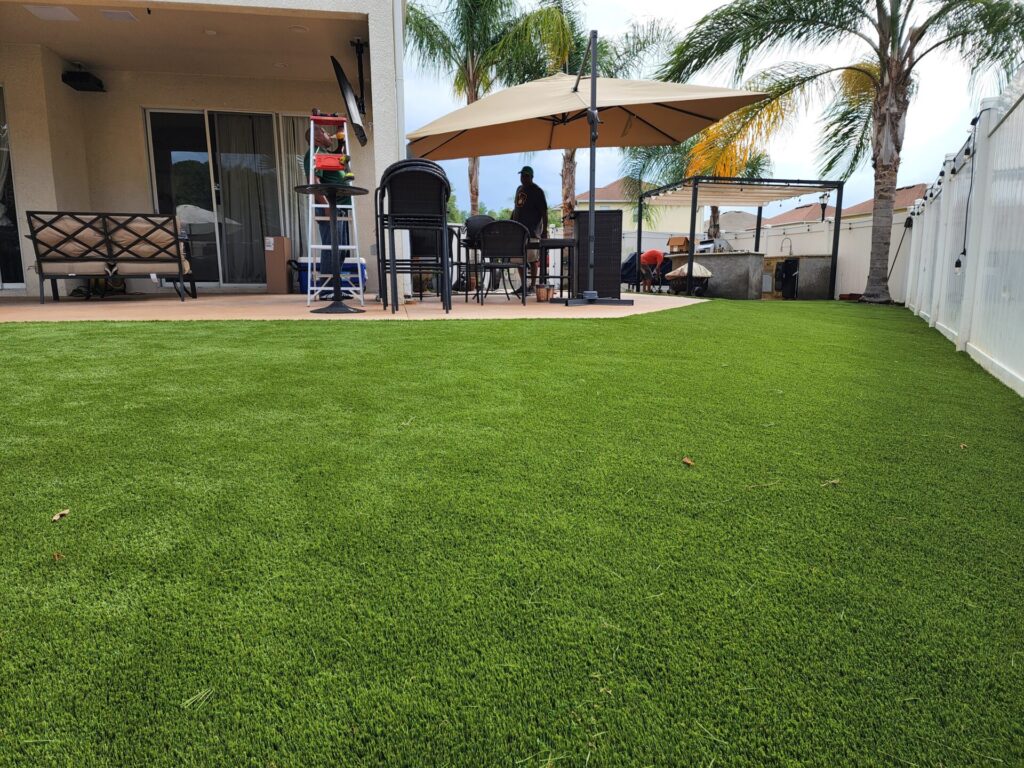
Finding Reliable Artificial Turf Installers
When it comes to installing synthetic turf, the choice of installer can significantly impact the quality, durability, and appearance of your new lawn. Whether it’s for a residential backyard, a commercial space, or a sports field, selecting a reliable installer is crucial. Here are some essential factors to consider when searching for the right artificial turf installer.
1. Experience and Expertise
One of the first things to look for in a reliable artificial turf installer is their level of experience and expertise. An experienced installer will have a proven track record of successful projects and will be well-versed in turf installation’s various techniques and challenges. Look for companies that have been in the business for several years and can provide examples of their work. It’s also beneficial to choose installers specializing in artificial turf rather than those offering it as one of many services.
2. Quality of Materials
The quality of the materials used in your artificial grass installation is paramount. Reliable installers will source high-quality turf that is durable, UV-resistant, and designed to withstand heavy use. It’s essential to ask about the specific types of turf they use and whether they meet industry standards. Some installers may offer various options to suit different needs and budgets, but they should always prioritize quality. Don’t hesitate to request samples and inquire about the longevity and maintenance requirements of the turf being offered.
3. Customer Reviews and Testimonials
Customer feedback is a valuable resource when evaluating potential artificial turf installers. Look for reviews and testimonials from past clients to get a sense of their satisfaction with the installation process and the final results. Reliable installers will have a portfolio of positive reviews and may even provide references upon request. Pay attention to comments about the professionalism, punctuality, and responsiveness of the installers, as these factors can greatly influence your overall experience.
4. Comprehensive Services
A trustworthy artificial turf installer will offer comprehensive services that go beyond mere installation. This includes site evaluation, preparation, and aftercare. Proper site preparation is crucial for the longevity and performance of your turf, so ensure the installer conducts a thorough assessment of the area, addresses any drainage issues, and properly levels the ground. Post-installation care and maintenance instructions should also be provided to help you keep your turf in optimal condition.
5. Warranty and Support
Finally, consider the warranty and support provided by the installer. A reliable company will stand by their work and offer a warranty covering the materials and the installation. Knowing that potential issues will be addressed promptly and professionally gives you peace of mind. Additionally, please inquire about the availability of ongoing support and maintenance services. A company that offers continuous support demonstrates a commitment to customer satisfaction and the long-term success of your artificial turf.
In conclusion, finding a reliable artificial turf installer requires careful consideration of their experience, the quality of materials they use, customer feedback, the comprehensiveness of their services, and the warranties and support they offer. By considering these factors, you can ensure a smooth installation process and enjoy a beautiful, durable artificial lawn for years to come.
4714 Cypress Tree Dr, Tampa, FL 33624, USA
(813) 212-7160
